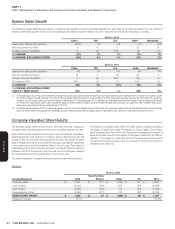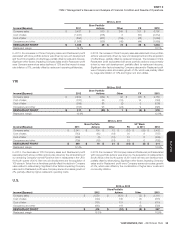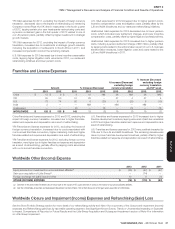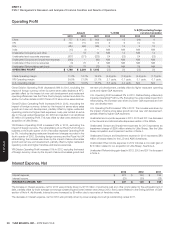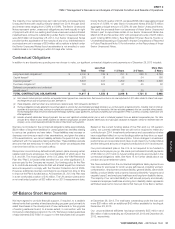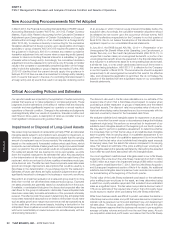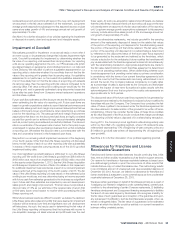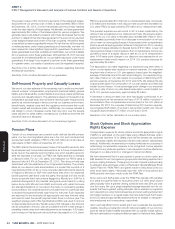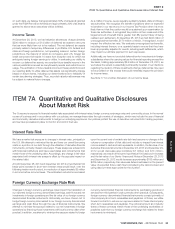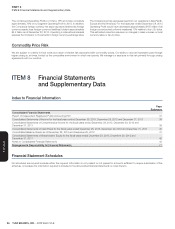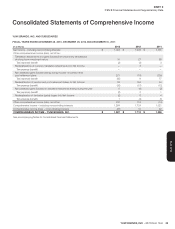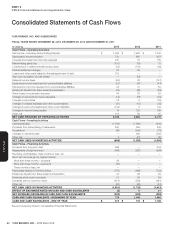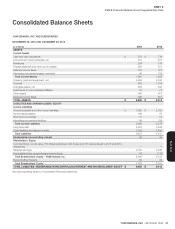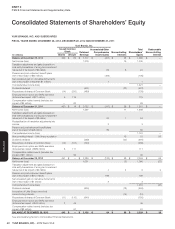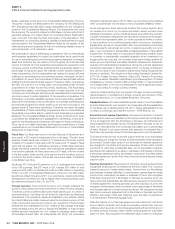Pizza Hut 2013 Annual Report Download - page 130
Download and view the complete annual report
Please find page 130 of the 2013 Pizza Hut annual report below. You can navigate through the pages in the report by either clicking on the pages listed below, or by using the keyword search tool below to find specific information within the annual report.
YUM! BRANDS, INC.-2013 Form10-K34
Form 10-K
PART II
ITEM7Management’s Discussion and Analysis of Financial Condition and Results of Operations
The present value of the minimum payments of the assigned leases,
discounted at our pre-tax cost of debt, is approximately $625 million
at December 28, 2013. Current franchisees are the primary lessees
under the vast majority of these leases. Additionally, we have guaranteed
approximately $40 million of franchisee loans for various programs. We
generally have cross-default provisions with these franchisees that would
put them in default of their franchise agreement in the event of non-payment
under assigned leases and certain of the loan programs. We believe these
cross-default provisions significantly reduce the risk that we will be required
to make payments under these guarantees and, historically, we have not
been required to make significant payments for guarantees. If payment on
these guarantees becomes probable and estimable, we record a liability
for our exposure under these guarantees. At December 28, 2013 we have
recorded an immaterial liability for our probable exposure under these
guarantees. If we begin to be required to perform under these guarantees
to a greater extent, our results of operations could be negatively impacted.
See Note 2 for a further discussion of our policies regarding franchise
and license operations.
See Note 19 for a further discussion of our guarantees.
Self-Insured Property and Casualty Losses
We record our best estimate of the remaining cost to settle incurred self-
insured workers’ compensation, employment practices liability, general
liability, automobile liability, product liability and property losses (collectively
“property and casualty losses”). The estimate is based on the results of an
independent actuarial study and considers historical claim frequency and
severity as well as changes in factors such as our business environment,
benefit levels, medical costs and the regulatory environment that could
impact overall self-insurance costs. Additionally, our reserve includes a
risk margin to cover unforeseen events that may occur over the several
years required to settle claims, increasing our confidence level that the
recorded reserve is adequate.
See Note 19 for a further discussion of our insurance programs.
Pension Plans
Certain of our employees are covered under defined benefit pension
plans. Our two most significant plans are in the U.S. and combined had
a projected benefit obligation (“PBO”) of $1,025 million and a fair value of
plan assets of $933 million at December 28, 2013.
The PBO reflects the actuarial present value of all benefits earned to date
by employees and incorporates assumptions as to future compensation
levels. Due to the relatively long time frame over which benefits earned to
date are expected to be paid, our PBOs are highly sensitive to changes
in discount rates. For our U.S. plans, we measured our PBOs using a
discount rate of 5.4% at December 28, 2013. This discount rate was
determined with the assistance of our independent actuary. The primary
basis for our discount rate determination is a model that consists of a
hypothetical portfolio of ten or more corporate debt instruments rated Aa
or higher by Moody’s or S&P with cash flows that mirror our expected
benefit payment cash flows under the plans. We exclude from the model
those corporate debt instruments flagged by Moody’s or S&P for a
potential downgrade (if the potential downgrade would result in a rating
below Aa by both Moody’s and S&P) and bonds with yields that were
two standard deviations or more above the mean. In considering possible
bond portfolios, the model allows the bond cash flows for a particular year
to exceed the expected benefit cash flows for that year. Such excesses
are assumed to be reinvested at appropriate one-year forward rates
and used to meet the benefit payment cash flows in a future year. The
weighted-average yield of this hypothetical portfolio was used to arrive at
an appropriate discount rate. We also ensure that changes in the discount
rate as compared to the prior year are consistent with the overall change in
prevailing market rates and make adjustments as necessary. A 50 basis-
point increase in this discount rate would have decreased our U.S. plans’
PBOs by approximately $70 million at our measurement date. Conversely,
a 50 basis-point decrease in this discount rate would have increased our
U.S. plans’ PBOs by approximately $79 million at our measurement date.
The pension expense we will record in 2014 is also impacted by the
discount rate we selected at our measurement date. We expect pension
expense for our U.S. plans to decrease approximately $60 million in 2014.
Thedecrease is primarily driven by a decrease in amortization of net loss
due to lower net unrecognized losses in Accumulated other comprehensive
income as well as lapping pension settlement charges from 2013, including
settlement charges allocated to Special Items of $10 million. Lower net
unrecognized losses in Accumulated other comprehensive income are
primarily a result of a higher discount rate at our 2013 measurement
date. A 50 basis-point change in our discount rate assumption at our
measurement date would impact our 2014 U.S. pension expense by
approximately $9 million.
The assumption we make regarding our expected long-term rates of
return on plan assets also impacts our pension expense. Our estimated
long-term rate of return on U.S. plan assets is based upon the weighted-
average of historical returns for each asset category. Our expected long-
term rate of return on U.S. plan assets, for purposes of determining 2014
pension expense, at December 28, 2013 was 6.9%. We believe this rate
is appropriate given the composition of our plan assets and historical
market returns thereon. A one percentage-point change in our expected
long-term rate of return on plan assets assumption would impact our
2014 U.S. pension expense by approximately $8 million.
A decrease in discount rates over time has largely contributed to an
unrecognized pre-tax actuarial net loss of $119 million included in
Accumulated other comprehensive income (loss) for the U.S. plans at
December 28, 2013. For purposes of determining 2013 pension expense,
we recognized $48 million of net loss in net periodic benefit cost. We will
recognize approximately $17 million of such loss in 2014.
See Note 14 for further discussion of our pension plans.
Stock Options and Stock Appreciation
RightsExpense
Compensation expense for stock options and stock appreciation rights
(“SARs”) is estimated on the grant date using a Black-Scholes option
pricing model. See Note 15 for details of the risk-free interest rate, expected
term, expected volatility and expected dividend yield used in valuing these
awards. Additionally, we estimate pre-vesting forfeitures for purposes of
determining compensation expense to be recognized. Future expense
amounts for any particular quarterly or annual period could be affected by
changes in our assumptions or changes in market conditions.
We have determined that it is appropriate to group our stock option and
SAR awards into two homogeneous groups when estimating expected term
and pre-vesting forfeitures. These groups consist of grants made primarily
to restaurant-level employees under our Restaurant General Manager Stock
Option Plan (the “RGM Plan”) and grants made to executives under our
other stock award plans. Historically, less than 10% of total options and
SARs granted have been made under the RGM Plan.
Stock option and SAR grants under the RGM Plan typically cliff-vest after
four years and grants made to executives under our other stock award
plans typically have a graded vesting schedule and vest 25% per year
over four years. We use a single weighted-average expected term for our
awards that have a graded vesting schedule. We re-evaluate our expected
term assumptions using historical exercise and post-vesting employment
termination behavior on a regular basis. We have determined that 5 years
and 6.25 years are appropriate expected terms for awards to restaurant-
level employees and to executives, respectively.
Upon each significant stock award grant we re-evaluate the expected
volatility, including consideration of both historical volatility of our common
stock as well as implied volatility associated with our publicly traded options.
We have estimated pre-vesting forfeitures based on historical data. Based


